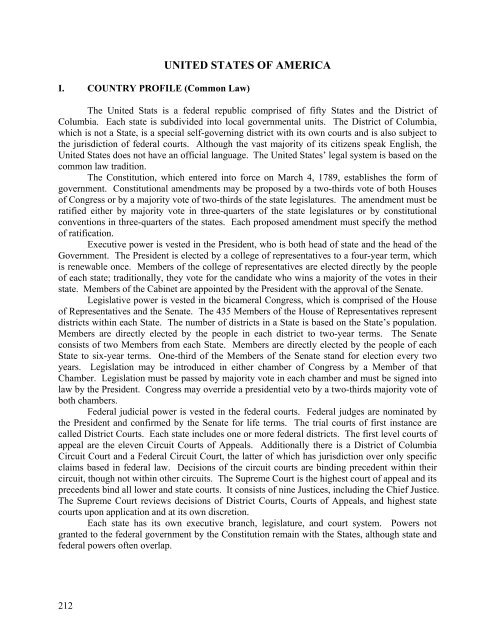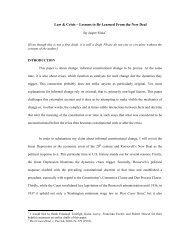Guide to Foreign and International Legal Citations - New York ...
Guide to Foreign and International Legal Citations - New York ...
Guide to Foreign and International Legal Citations - New York ...
You also want an ePaper? Increase the reach of your titles
YUMPU automatically turns print PDFs into web optimized ePapers that Google loves.
212<br />
UNITED STATES OF AMERICA<br />
I. COUNTRY PROFILE (Common Law)<br />
The United Stats is a federal republic comprised of fifty States <strong>and</strong> the District of<br />
Columbia. Each state is subdivided in<strong>to</strong> local governmental units. The District of Columbia,<br />
which is not a State, is a special self-governing district with its own courts <strong>and</strong> is also subject <strong>to</strong><br />
the jurisdiction of federal courts. Although the vast majority of its citizens speak English, the<br />
United States does not have an official language. The United States’ legal system is based on the<br />
common law tradition.<br />
The Constitution, which entered in<strong>to</strong> force on March 4, 1789, establishes the form of<br />
government. Constitutional amendments may be proposed by a two-thirds vote of both Houses<br />
of Congress or by a majority vote of two-thirds of the state legislatures. The amendment must be<br />
ratified either by majority vote in three-quarters of the state legislatures or by constitutional<br />
conventions in three-quarters of the states. Each proposed amendment must specify the method<br />
of ratification.<br />
Executive power is vested in the President, who is both head of state <strong>and</strong> the head of the<br />
Government. The President is elected by a college of representatives <strong>to</strong> a four-year term, which<br />
is renewable once. Members of the college of representatives are elected directly by the people<br />
of each state; traditionally, they vote for the c<strong>and</strong>idate who wins a majority of the votes in their<br />
state. Members of the Cabinet are appointed by the President with the approval of the Senate.<br />
Legislative power is vested in the bicameral Congress, which is comprised of the House<br />
of Representatives <strong>and</strong> the Senate. The 435 Members of the House of Representatives represent<br />
districts within each State. The number of districts in a State is based on the State’s population.<br />
Members are directly elected by the people in each district <strong>to</strong> two-year terms. The Senate<br />
consists of two Members from each State. Members are directly elected by the people of each<br />
State <strong>to</strong> six-year terms. One-third of the Members of the Senate st<strong>and</strong> for election every two<br />
years. Legislation may be introduced in either chamber of Congress by a Member of that<br />
Chamber. Legislation must be passed by majority vote in each chamber <strong>and</strong> must be signed in<strong>to</strong><br />
law by the President. Congress may override a presidential ve<strong>to</strong> by a two-thirds majority vote of<br />
both chambers.<br />
Federal judicial power is vested in the federal courts. Federal judges are nominated by<br />
the President <strong>and</strong> confirmed by the Senate for life terms. The trial courts of first instance are<br />
called District Courts. Each state includes one or more federal districts. The first level courts of<br />
appeal are the eleven Circuit Courts of Appeals. Additionally there is a District of Columbia<br />
Circuit Court <strong>and</strong> a Federal Circuit Court, the latter of which has jurisdiction over only specific<br />
claims based in federal law. Decisions of the circuit courts are binding precedent within their<br />
circuit, though not within other circuits. The Supreme Court is the highest court of appeal <strong>and</strong> its<br />
precedents bind all lower <strong>and</strong> state courts. It consists of nine Justices, including the Chief Justice.<br />
The Supreme Court reviews decisions of District Courts, Courts of Appeals, <strong>and</strong> highest state<br />
courts upon application <strong>and</strong> at its own discretion.<br />
Each state has its own executive branch, legislature, <strong>and</strong> court system. Powers not<br />
granted <strong>to</strong> the federal government by the Constitution remain with the States, although state <strong>and</strong><br />
federal powers often overlap.
















